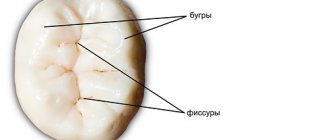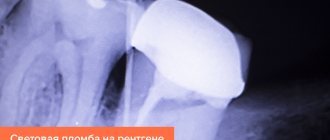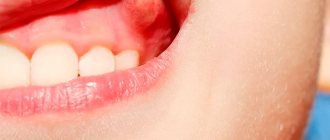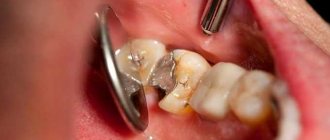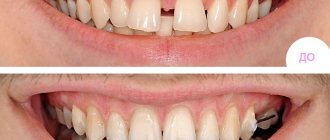- Types of products
- Ceramic inlay e max: main indications
- Contraindications for installing ceramic inlays
- Ceramic tooth inlay: advantages and disadvantages of products
- Manufacturing and installation stages
- Ceramic dental inlay: care features
If it is necessary to carry out extensive restoration, they often resort not to filling material, but to ceramic inlays (onlays).
They are one of the best methods of dental restoration and provide high-quality results. Ceramic inlays are a microprosthesis that is fixed in the tooth cavity. Such orthopedic structures are characterized by high aesthetics and durability; they are completely identical to healthy enamel, due to which they have become widespread. The e max ceramic inlay is in particular demand; it can be installed in a reliable dental clinic “A-medic”. The company's pricing policy is loyal, the cost of the service starts from 15,000 rubles. Before installing a microprosthesis, dentists conduct an examination and diagnosis to identify possible contraindications. In dentistry, a ceramic inlay is installed in just 2 stages, which allows you to quickly make your smile more attractive. An individual approach to each patient is guaranteed.
What kind of design is this
A ceramic dental inlay is a microprosthesis1 that restores the integrity of a tooth when it is less than half destroyed. Such microprostheses are called “restorative inlays”, and they are installed not by dental therapists, but by orthopedic dentists (“prosthetists”). Externally, ceramic masonry looks like a piece of your own tooth - more precisely, the missing area on a natural crown, with all the tubercles and grooves-fissures. When a microprosthesis is fixed, it, like the last piece of a “puzzle,” restores the integrity of the tooth.
The resulting restoration looks very natural – indistinguishable from a “native” tooth. This is due to the properties of ceramics, which are now produced using advanced technologies - with natural light refraction, translucency, color and transparency transitions in different areas of the ceramic.
Restorative microprostheses are often compared to fillings or even confused with stump inlays. Next, we’ll tell you how they differ – after all, these are still different concepts.
Complex on 4 OSSTEM implants with delayed loading - 150,000 rubles.
Complex implantation Osstem (South Korea) with delayed loading after 4-6 months.
Doctor's work guarantee - up to 5 years (under an agreement on the provision of medical services) Call now or order a call
Opening hours: 24 hours a day - seven days a week
What is a dental inlay
A dental inlay is a non-removable microprosthesis, with the help of which the anatomical shape of a tooth damaged by any disease or mechanical injury is restored. The strength of such an inlay is not inferior to tooth enamel.
Modern technologies make it possible to produce microprostheses that are practically indistinguishable in shape and color from real teeth.
A microprosthesis differs from a conventional filling in its manufacturing method and service life. The inlay is created using a special technology, which allows you to repeat the natural shape of the tooth and increase its service life.
How is it different from a filling?
As most people in the world know (after all, up to 90% of the inhabitants of our planet experience caries), a filling is placed after drilling a tooth and restores its integrity. Therefore, the installation of a filling is sometimes called prosthetics. But, firstly, fillings are made from liquid or soft composites. Secondly, these materials are introduced into the dental cavity and harden (under the influence of air or a “blue” lamp). This is called the direct manufacturing method - i.e. in the dentist's chair and in one visit, which lasts no more than an hour.
Unlike a filling, ceramic inlays are typically made from a solid piece of ceramic and the manufacturing process takes place in a dental laboratory. Only after this the microprosthesis is installed on the tooth. This method is called indirect. And when deciding which is better - a filling or a ceramic inlay, in almost all cases the scales tip in favor of the latter. Because microprostheses have undeniable advantages - they fit more tightly to the dental walls, do not sag at all over time, look very natural and last about 10 years.
According to experts, fillings often peel off and fall out, sag after 1-2 years and last a maximum of 5 years. The only option when the filling will be better is if the destruction is very small (in this case, the ceramic inlay will not be securely attached to the tooth).
Price
| Included in the price |
|
| Paid separately |
|
| Affect size |
|
Differences from the stump tab
It’s very easy to understand how a ceramic inlay differs from a stump inlay. What is restorative ceramic is already clear, it was discussed above. And the stump is a more voluminous structure, which is a prosthetic tooth stump (by the way, it can also be ceramic). It is placed when the natural crown is very badly destroyed, even down to the gum level. The lower part of the stump is installed in the roots, and the upper part rises above the gum. The function of the core is to serve as a support for a crown or bridge.
That is, you can replace a restorative (or microprosthesis) only with a filling, but not with a stump insert - this is already an independent type of prosthesis.
Prices
| Service | Price |
| Consultation + treatment plan | For free |
| Recovery tab (E-max material) | 23 300 ₽ |
Expert of the article you are reading: Akhtuba Daria Dmitrievna Orthopedic dentist, leading specialist of the NovaDent network
11 years
Clinical experience
Academic
st. Dmitry Ulyanov, 36
+7
Free consultation with this specialist
Classification of recovery tabs
First of all, microprostheses are distinguished by size - i.e. what crown area do they restore? This leads to the following classification:
- inlay (“inlay”): this is a very small ceramic liner that is installed in the tooth cavity and does not affect the cutting cusps of the crown,
- onlay (“onlay”): this ceramic onlay is slightly larger in size, it restores the internal slopes of the cutting cusps of the tooth,
- overlay (“overlay”): the onlay can completely cover the upper part of the natural crown and also restore the outer slopes of 1-3 tubercles. But, at the same time, this is not a full-fledged artificial crown, but an analogue of its top.
- pinlay (“pinlay”): such an overlay is equipped with a “pin” or pin (it is also ceramic and is a monolith with a microprosthesis). The pin goes deep into the dentin layer and is necessary for better retention of the restoration in the dental cavity - because “Pinley” restores not only the cutting edge, but also the tooth wall. In some ways, pinlay can be compared to a veneer, only the veneer is placed on the front surface, and “pinlay” is placed on the lingual surface of the tooth.
Kinds
Today, there are 3 types of ceramic inserts widely used in dentistry. Each of the elements has its own characteristics and is assigned under certain conditions.
Zirconium dioxide
Blanks made from the specified material are subject to subsequent turning. To obtain a model of the tooth and adjust the product to it, the prosthetist uses a plaster cast. It is installed in the oral cavity and completely follows the contours and cavities of the molar.
The turning process is automatic, it is carried out by a given program. The final product is fired and mixed with porcelain, after which it is installed on the patient.
This insert has an important advantage: the manufacturing process is not manual, therefore, errors are excluded. In addition, zirconium dioxide can be compared to metal in strength.
Pressed ceramics
During the production process of the liner, porcelain is treated with high pressure and temperature. The result is an excellent insert option that has enhanced aesthetic characteristics. Pressed ceramics have one drawback - this material is inferior to zirconium in terms of strength.
Metal ceramics
Products for dental prosthetics made from these raw materials are an innovation in dentistry. That is why experts have not yet improved the material. According to patient reviews, metal-ceramic inlays fall out very often. This occurs due to the difference in the indicators of the two components.
Composite
Another type of inlay, characterized by the same parameters as a regular filling. Over time, the composite product fades and darkens.
The most popular and used today is the all-ceramic insert. It is resistant to stress, aesthetically attractive and closely resembles enamel and dental tissue.
Indications for installation
Indications for the installation of ceramic dental inlays are the following:
- destruction of the natural crown by 50% or less: this can be caused by caries, pulpitis, trauma, increased abrasion of the enamel,
- loss or need to replace an old filling,
- secondary caries under a filling: because it does not adhere very tightly to the walls of the cavity, then microbes penetrate under it, destroying enamel and dentin,
- restoration of a tooth that will serve as a support for a prosthesis (bridge, adhesive bridge or removable denture).
Read on the topic: comparison of removable dentures - the pros and cons of different designs, which is better to choose depending on the situation.
Product installation technology
Below is a detailed process for installing ceramic products.
Table. Procedure for installing ceramic inlays.
| Steps, photo | Description of actions |
| Step one | If there are old fillings, they are first removed using a special machine. Cooling with water helps prevent tooth overheating. Grinding of the tooth being restored occurs using magnifying instruments, most often binocular glasses. This is due to the need to preserve as much healthy dental tissue as possible. |
| Step two | After grinding, the tooth surface is treated with a special tool - a caries detector. It is washed off the teeth when rinsing with water. The caries detector allows you to check whether all damaged tooth tissue has been removed from the patient. |
| Step three | After this, precise grinding is carried out, and at the end all edges of the processed tooth are smoothed with an Arkansas stone. All these actions are necessary to improve the fit of the ceramic inlay. |
| Step four | Before taking an impression, a special protective agent is applied to the tooth, which is also washed off when rinsing. After this, an impression is taken for the dental technician. The test is also carried out using binocular glasses. |
| Step five | Now the manufactured tab is glued. For this purpose, different types of glue are used: some harden under the influence of ultraviolet light, others need to be mixed before application. In any case, the doctor must strictly follow the manufacturer's instructions. This also applies to all substances for treating teeth, including special polishing pastes, etching gel, glycerin gel for glue hardening, and so on. |
On a note! There are special rules of oral hygiene that the patient must follow after installation of the structure. This will reduce the load placed on the restored tooth, as a result of which the microprosthesis will last much longer.
What is a contraindication
Ceramic inlays are not used on children's baby teeth because they are inappropriate. Baby teeth last less than a ceramic microprosthesis. Also considered a contraindication is the destruction of more than 50% of the area of the natural crown or the preservation of less than 2 of its walls. If the patient suffers from bruxism, he will have to wear special protective mouth guards at night to prevent the ceramic from cracking due to strong jaw compression.
It is worth noting that in the vast majority of cases, inlays are installed only on chewing teeth - premolars (“four”, “five”) and molars (“six”, “seven”). Third molars or “eights” are rarely restored in this way, as are teeth in the frontal zone (only from the inside using pinlay restoration).
Fillings and ceramic inlays for teeth: what is the difference
The main advantages of the tab are its natural appearance, strength, and durability. It is practically indistinguishable from healthy tooth enamel. An impression of the inlay is created individually for each patient and accurately replicates the anatomical features of the lost part of the tooth. This relieves the patient from the sensation of a foreign body in the mouth, which often occurs after the installation of a filling.
Installing an inlay is the most preferred method of restoring chewing teeth, since they bear a high load when chewing food.
The color of the ceramic microprosthesis is selected individually, taking into account the basic tone of the patient’s enamel.
Disadvantages of ceramic inlays
There are quite a few disadvantages of microprostheses. Firstly, there are contraindications. Secondly, if you carefully study patient reviews about ceramic inlays for teeth, you will notice that some of them are not very happy with the cost of restoration - which is several times higher than that of fillings. But the high cost is due to the price of consumables (mostly foreign ones of very high quality are used), as well as the complexity of manufacturing. And if we take into account the long service life of microprostheses, then in the future they will more than pay for themselves. After all, the same filling will have to be changed in 3-5 years (or earlier), a new one will have to be installed - and if it is severely damaged, an artificial crown will have to be installed.
Don't know what type of prosthetics to choose?
We will help in the selection, advise where to read more information and compare types of prosthetics.
Consultation with an orthopedic doctor in Moscow clinics is free! Call now or request a call
Working hours: from 9:00 to 21:00 - seven days a week
Advantages and disadvantages
The popularity of ceramic dental inserts is due to a large number of advantages. Patients highlight the following advantages:
- Durability. The material used to produce the product has increased strength, which ensures a long service life.
- Aesthetics. Ceramics is quite similar in structure to tooth enamel. That is why the insert allows you to achieve a pristine appearance.
- Adequate treatment. The design provides protection from aggressive environments.
- Preparation for prosthetics. The production of inlays requires high precision, which is why they are used for pre-treatment of teeth for crowns.
- Reduced wear of tooth enamel. In addition to this positive point, ceramics do not tend to shrink or change heights during operation.
The main disadvantage that most patients note is the cost of the insert, which is several times higher than a conventional filling. This shortcoming is covered by the higher quality of the product. Another disadvantage is the duration of the procedure: sometimes installation will require several visits to the doctor.
In general, ceramic inlays for teeth have proven themselves to be good. They help restore the integrity of molars, protecting them from further exposure to disease. With proper care, the tab will have a long service life.
Types and brands of ceramic materials
Types of ceramic inlays differ in materials. Since ceramics include not only porcelain (in the classical view, this is ordinary feldspar), but also ceramic raw materials with various additives - they are also called “metal-free ceramics”. Let's take a closer look at the materials used:
- feldspathic ceramics: usually these are liquid or plastic materials for layer-by-layer application and baking in a special oven, for cladding - i.e. to enhance the aesthetics of other materials. For example, the Shofu brand Vintage Halo, VITA VM 13 from VITA Zahnfabrik, IPS e.max Ceram. They have good aesthetics, but lower strength (40-60 MPa) compared to more modern materials. It is worth adding that feldspar in different concentrations can be added to different types of ceramics,
- nanoceramics: liquid raw materials containing submicron glass - for example, ceram.x Sphere TEC material from Dentsply Sirona. Can be used both for filling and for making microprostheses in the laboratory,
- leucite glass ceramics: contains leucite crystals, which give the ceramics strength (160 MPa) and translucency with a “chameleon” effect. Typically, manufacturers produce glass ceramics in 7-12 color and transparency options, which makes it universal for both young and elderly patients. Popular brands are IPS Empress Esthetic ET, IPS Empress CAD HT from Ivoclar Vivadent and VITABLOCS Mark II from VITA Zahnfabrik. The material is processed according to the principles of injection molding or milling using a CAD/CAM system, produced in the form of blocks or small cylinders,
- glass ceramics based on lithium disilicate: such glass ceramics have increased strength (470 MPa) and allow you to create aesthetic restorations regardless of the original shade of the tooth. The highest quality brand is IPS e.max Press HT from Ivoclar Vivadent. In general, "E.Max" is considered an advanced material for pressing technology,
- reinforced glass ceramics (based on lithium disilicate and zirconium dioxide): strengthened material (more than 500 MPa) containing 10% zirconium dioxide. For example, Celtra Press and Celtra Duo from Dentsply Sirona, which are primarily suitable for inlay and onlay restorations,
- hybrid ceramics: ceramic-polymer properties give the material strength and elasticity - the ability to absorb chewing loads without destroying the structure (VITA Enamic T, HT, ST brand),
- zirconium dioxide: the most durable material (up to 1400 MPa), which belongs to metal-free ceramics. It is processed only by milling (we will discuss the methods below). Many manufacturers produce zirconium dioxide only in white, but the most progressive ones have learned to color it in natural shades. Popular brands – IPS e.max CAD, Prettau Zirkon from Zirkonzahn.
Contact the professionals
If you need installation of ceramic microprostheses at a reasonable price in Moscow or the Moscow region, the NovaDent network of dental clinics is waiting for you in one of its fifteen institutions. We use the best innovations to create flawlessly radiant, healthy smiles. The use of modern materials and technologies, as well as the high qualifications of our doctors, guarantees ease and painlessness of treatment in the shortest possible time. At each NovaDent clinic, polite staff and sincere care await you.
Make an appointment at a convenient time now! Trust your health to professionals!
What stages are included in microprosthetics?
- preparation: the dentist removes the remains of the old filling or prepares enamel and dentin affected by caries, if necessary, treats and fills the root canals,
- taking impressions: impressions are taken not only from the causative tooth, but also from those with which it contacts or intersects. A more modern method is a 3D scan of the oral cavity, the parameters of which are entered into a computer program. Next, the patient is given a temporary filling for several days or weeks to protect the tooth from infection and damage.
- creation of a model: a physical model is created in the laboratory, which is tried on the patient (here you can make additions or adjustments to make an ideal microprosthesis),
- manufacturing: during the manufacturing stage, the final version of the ceramic inlay is created. To improve aesthetics, it can be painted, lined with ceramics, polished - so that the restoration takes on a natural shine and food coloring is not absorbed into the material,
- fixation of the finished ceramic inlay: for this it is recommended to use three-stage fixation materials, for example, the Syntac universal adhesive system from Ivoclar Vivadent.
The entire process of preparation, manufacturing, and adjustments may take 1-3 weeks (depending on the workload of the laboratory). Fixation occurs within 20-30 minutes, and here it is important to carefully remove the temporary filling, as well as treat the cavity with an antiseptic.
“Not long ago I got myself a ceramic filling, or rather an inlay. That's what the prosthetist called her. Looks very real, like your own tooth. But the downside is that it takes a long time to do it. And all this time you need to chew carefully. Otherwise, you can chip a tooth with a temporary filling. Then you’ll have to make new impressions and a new prosthesis, and pay again.” Artem I., review from otzovik.com
How are inlays made?
All methods for making ceramic inlays are indirect – i.e. in a laboratory setting. Liquid materials for layering and subsequent baking techniques are rarely used as the main method. More often - for lining the frame of metal-free ceramics made of lithium disilicate or zirconium dioxide.
Also, ceramic microprosthesis can be made by injection molding. Another method (characterized by ideal anatomy and fit into the dental cavity) is the use of CAD/CAM systems. Here, the model of the future microprosthesis is first worked out in a computer program and then milled on a machine.
Manufacturing and installation stages
Manufacturing and installation of an orthopedic structure is not difficult and does not take much time. At the initial appointment, the dentist examines the oral cavity to determine indications and contraindications for the procedure. If contraindications are identified, they are eliminated, after which they proceed to therapy. If necessary, endodontic treatment and hygienic treatment of the diseased tooth are carried out. By analogy with standard filling, the specialist removes all destroyed tissue from the tooth, forming an area for a microprosthesis. After this, a cast is made that exactly repeats its shape.
The production time for an emax ceramic inlay based on the impression obtained (3D modeling results) is about 5-10 days. At this time, a temporary filling material is placed in the patient's cavity. The onlay is made in laboratory conditions, taking into account the individual characteristics of the patient’s dental system. The orthopedic structure is fired and covered with layers of ceramics. At the secondary appointment, the patient’s temporary filling is removed and a finished microprosthesis is installed. It is attached using special cement, which firmly adheres to the ceramics and enamel of the tooth. This guarantees a secure fit. At the end of the process, the surface is polished. The whole procedure takes no more than 120-150 minutes.
Service life and care features
On average, the service life of ceramic inlays is 10 years, but in the case of metal-free ceramics it can increase to 15-20 years. Of course, with quality care. But there are no difficulties in it - you need to brush your teeth twice a day, rinse your mouth after every meal. Ideally, use a waterpik to remove any stuck pieces. Remember that chewing very hard food and using teeth for other purposes (opening lids, for example) can damage the restoration. You should also visit your dentist twice a year for examinations and professional oral hygiene.
How much does microprosthetics cost?
The prices of ceramic inlays for teeth in Moscow and other cities are approximately the same, because... materials and equipment are usually purchased from the same manufacturers. For example, the cost of an inlay/onlay microprosthesis made of ceramics starts from 15 thousand, from metal-free ceramics (glass ceramics and zirconium dioxide) - from 20 thousand rubles.
1Chaika Z., Ron G.I. Optimization of dental restoration with ceramic inlays. Microprosthetics, 2012.
Author: Chernov A. R. (Thank you for your help in writing the article and the information provided)
Care
To ensure the durability of the ceramic inlay and ensure that the molar does not bother you anymore, it is recommended to adhere to the basic rules of dental care after the procedure:
- do not additionally and unnecessarily load the installed inserts;
- take care of your teeth as usual on a daily basis;
- Rinse your mouth with water after eating food.
The main feature that determines one of the advantages of these products is the lack of special care, which is necessary for other types of treatment. A standard ceramic inlay has a warranty period of 5 years. Proper care will extend the life of the element.

